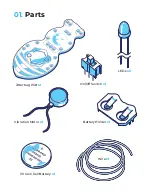
Above is the correct setup for creating a strong
solder joint. Your goal is to heat both the lead
of the part being solder and the solder pad.
Then introduce the solder itself. By heating the
lead and pad correctly the solder will flow
around them to create a strong joint.
Your soldering iron should be set to at least
450F and less than 700F. If your solder iron
does not have a temperature dial no problem!
Just plug it in a go. Hold the tip of the iron to
the lead and pad for about three seconds
before introducing the solder. Don’t worry if
you heat up the board a bit, it is designed to
withstand hot temperatures.
Hold the solder between your forefinger and
thumb about four to six inches from the end.
The solder is going to melt really quickly so you
don’t want your finger to be too close to the
end. Touch the solder to the solder pad. It
should liquify almost instantly and flow into
the joint. Move the solder around a bit to cover
the entire solder pad. You don’t need very
much to create a clean solder joint. It should
only take a few seconds.
Pull the solder away first and then the
soldering iron. Viola! You have just created your
first soldering joint! Your solder joint should
look something like the image below.
Soldering
Iron Tip
Lead of Part
Solder Pad
Solder
03.
Technique
GOOD
OKAY
A little metal mountain
resembling a hershey kiss.
Fully covered solder pad, you
should see no more gold.
The solder is not fully on the
solder pad. You still see some
gold visible. Give it a another
try. Just reheat the solder joint
and add a little more solder.
A blobby solder joint that is
more spherical. You can use
less solder next time. The
electronics should still work!
BAD
Содержание Jitterbug
Страница 1: ......


























